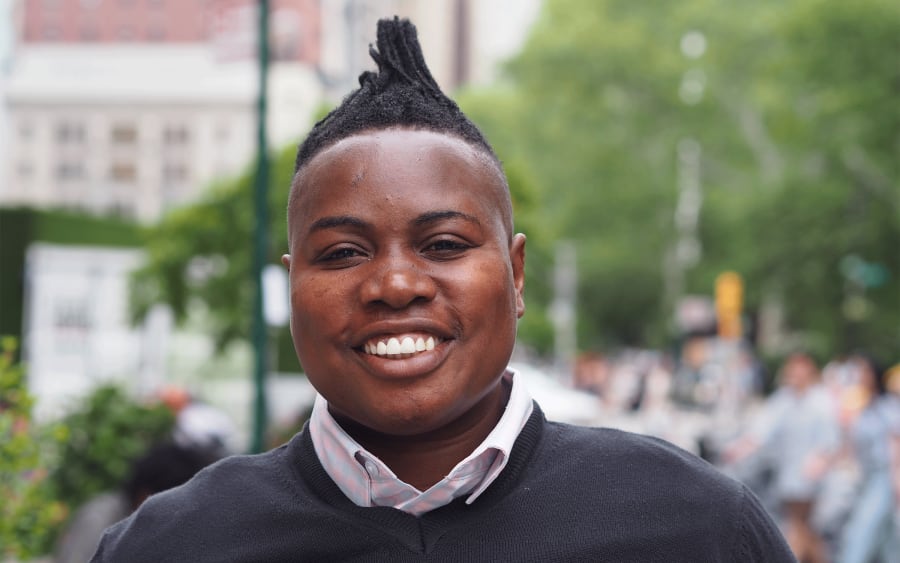From a distance, a work by Mitsuko Asakura might read as a linear interplay of glowing, expressionist color – until the middle drops out in a pendulous swoop of slackened silk. The Kyoto-born septuagenarian textile artist, who fuses traditional fiber dyeing and European tapestry methods with experimental forms, has been revered among a community of craftspeople in Japan. But it was not until her inclusion in a group show at collector Lisa Perry’s female-focused Onna House in East Hampton, New York, in 2022, that her work was noticed by a board member of the Museum of Arts and Design and subsequently entered the permanent collection.
While giving full credit to the Asakura’s sublime creations, Perry says that as result of the artist’s visibility in the show, ‘her work is now in a dozen collections that she might not have been in.’ Such is the power of a tastemaking eye like Perry’s. A fashion designer, curator, and Modernism enthusiast, Perry is a leading example of the current class of activist female collectors, including Yan Du, Pamela Joyner, Grażyna Kulczyk, and Komal Shah, who are using their varied backgrounds, connections, and purchasing power to consciously shift the market – and, they hope, the canon, too.
Data collected by Dr. Clare McAndrew in the Art Basel and UBS Survey of Global Collecting in 2023 backs up the trend. While male collectors still grab headlines for splashy spends – there were more than double the number of men spending over the USD 1 million mark – the picture painted by McAndrew is one of sustained and increasingly serious participation by female collectors. Although both genders saw a rise in 2022, women’s median expenditure outpaced that of men in the first half of 2023, building on earlier growth: ‘With a median of USD 72,500, women spent more than men in 2023 and the two previous years.’ The sample reflects an overall gender breakdown of 40% women, 60% men, with 0.2% identifying as nonbinary; however, there was some variance by region, with women making up more than half the respondents in Japan and Hong Kong. Additionally, there was a higher proportion of female respondents (58%) in the boomer age group (the wealthiest in the world, according to Forbes).
Demographics are not destiny, of course, but it is fair to wonder how women’s increasing buying power might be shaping the market. As a topline trend, McAndrew notes that HNW collectors spent less on works by female artists in 2022 and 2023, and the share of works by women in their collections slipped by 3%, to 39%. But, she notes, for those spending north of USD 10 million on art per annum – arguably the most engaged and informed group – collectors in the sample put nearly 9% more toward female artists in 2023 than in 2021. ‘This could indicate that, although undertaken by a minority of collectors, some of the spending at the very highest levels was on female artists,’ McAndrew writes.
While acknowledging some directionality, those in the industry are split on whether women are entering collecting at any greater rate than previous years; many note the prevalence of couples who make a project of collecting together. The Hong Kong-based advisor Yuki Terase, of Art Intelligence Global, says, ‘It would be easier to say, “Oh, women are becoming more independent and gaining more spending power; hence there’s a rise.” I don’t think it’s that simple.’ Jeanne Greenberg Rohatyn, founder of New York’s Salon 94, says that her experience of the past 3 years ‘absolutely tracks’ with McAndrew’s findings, with women drawn to her female-focused program, which includes Marilyn Minter, Kennedy Yanko, and Karon Davis. She points to the salience of subjects tackled by female artists to the historical moment. ‘We live in a world where women’s bodies are under threat, there are wars underway that are very male-driven... Art by women is, effectively, the art of our time. No one who collects can ignore it.’
However, a few gendered generalities still hold. ‘I do feel female collectors tend to enjoy the social aspects of art collecting. There are men who collect, but absolutely hate coming to these events,’ says Terase. She adds, ‘I think women are less driven by art as an asset class. They do their homework, but it’s more on the historical importance of the artists.’ Greenberg says, ‘I have male collectors who follow auctions and statistics who just won’t buy anything without the numbers to back them up. I don’t find that same pattern with the women.’
Mary Sabbatino is vice president and a partner at New York’s Galerie Lelong & Co., which alongside contemporary artists represents several significant estates of women artists, including Ana Mendieta and Etel Adnan. Sabbatino has found that her female clients are ‘more open to a multiplicity of creation rather than a straight line. The straight line is easier to understand, especially in the market... you can move a painting easily. But sculpture, fabric, weird materials? It gets harder.’ Greenberg concurs: ‘A sense of patronage is embedded in their buying power; I think confidence as well. And not minding being a little on a margin sometimes.’
Hong Kong gallerist Lorraine Kiang, of Kiang Malingue, which represents a program of Asian and diaspora artists including Wong Ping, Tiffany Chung, and Samson Young, says that the rise of social justice movements globally has spurred curiosity about underrepresented categories, ‘and this interest, I would say, has been further encouraged by female collectors.’ But purchases filter along age and budget lines. Younger collectors, Kiang finds, are more likely to collect agnostically and intuitively, regardless of medium or name recognition: ‘it’s purely what they connect with,’ she says, mentioning strong demand among women for paintings by Brook Hsu and Liu Xiaohui. Established collectors with bigger budgets are buying with an eye toward how their support can further an artist’s institutional recognition, via loans to museums, say. ‘There are a few in Asia who are actively doing that, who are female,' she says.
The Bay Area-based tech executive Komal Shah started collecting 10 years ago with her husband, Gaurav Garg, building on a shared love of abstraction. Some 100 selections – all by women – from the couple’s holdings are currently on view (through March 23) in New York City in the touring exhibition ‘Making Their Mark’, curated by Cecilia Alemani, who was also responsible for the feminist-slanted 2022 Venice Biennale. Intermingled with sweeping abstract canvases by Mary Weatherford, Charline von Heyl, and Laura Owens are textile installations by Olga de Amaral and Françoise Grossen, quilts by Qunnie Pettway and the Gee’s Bend quilters, and ceramics by Toshiko Takaezu. ‘Our collection celebrates excellence by artists who happen to be women,’ Shah says. ‘The fact that they were still underrecognized by the world – not just the market, but also from a museum perspective – I felt that if I was going to really be collecting in depth and breadth, that I wanted to make it a mission to focus on women and getting to gender parity in the near future.’
Impact-based, philanthropic purchasing – for a private museum, a foundation, or as a board member of an institution – is another commonality of female-founded collections. Perry, who spent decades building a personal art collection with her husband, Richard, launched Onna House with an outward-facing mission – one that preserves it as a platform for women’s art and craft exclusively. ‘Men say to me, “Isn’t that reverse sexism?” Women come in and they read this manifesto, and they absolutely love it,’ says Perry. ‘I feel like it inspires them to say: “This is fantastic. We want more women in our collection, and we want to buy this art ourselves.”’ Onna House is a community, she adds. ‘We want people to see the story behind the art.’
‘I'll be honest, I struggled with the whole idea of a female collector collecting works by women,’ says Shah. ‘But I’m just doing what I believe in doing.’ She describes a 360-degree mentality to her approach: ‘I personally believe that to support women artists, that we need an entire ecosystem regardless of gender to be supporting them. I think that it's not just female collectors that are going to move the needle, it's got to be all collectors. And I worry about collecting female artists becoming a fad or a checklist.’
Perhaps the ideal future state, says Terase, ‘is being known not for your gender but because of what you do and what you support. Ultimately, that’s the goal.’
Sarah P. Hanson is a New York–based writer specializing in contemporary art and the art market
Caption for top image: View of Etel Adnan’s artwork in Sfeir-Semler Gallery’s booth in the Unlimited sector of Art Basel in Basel 2021.
Published on March 7, 2024.


